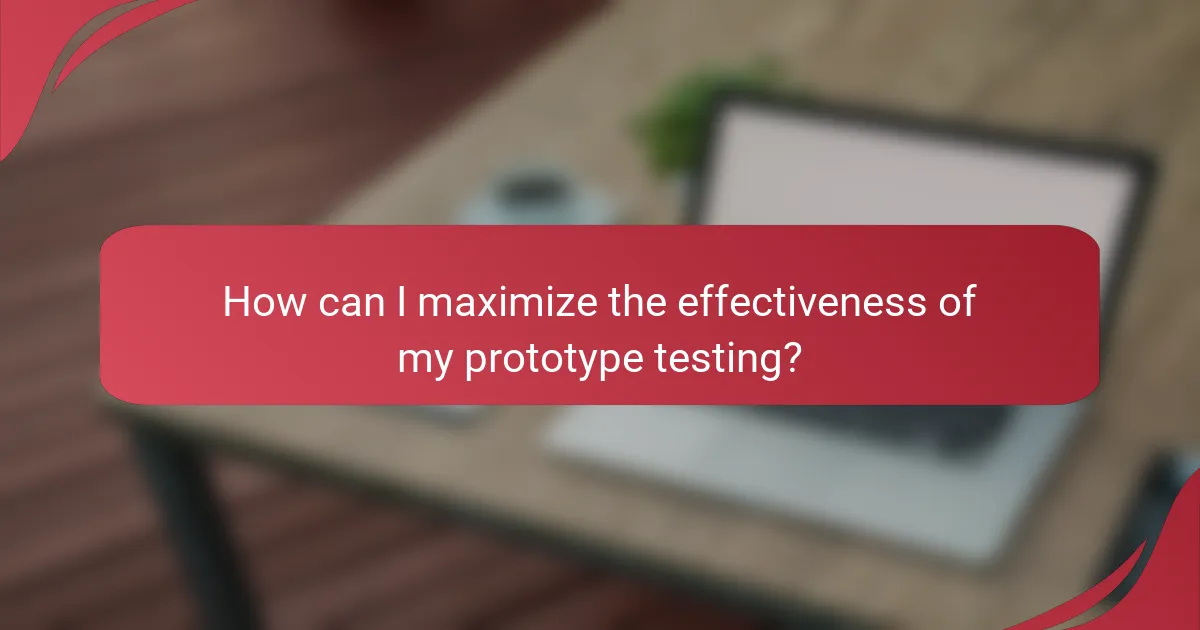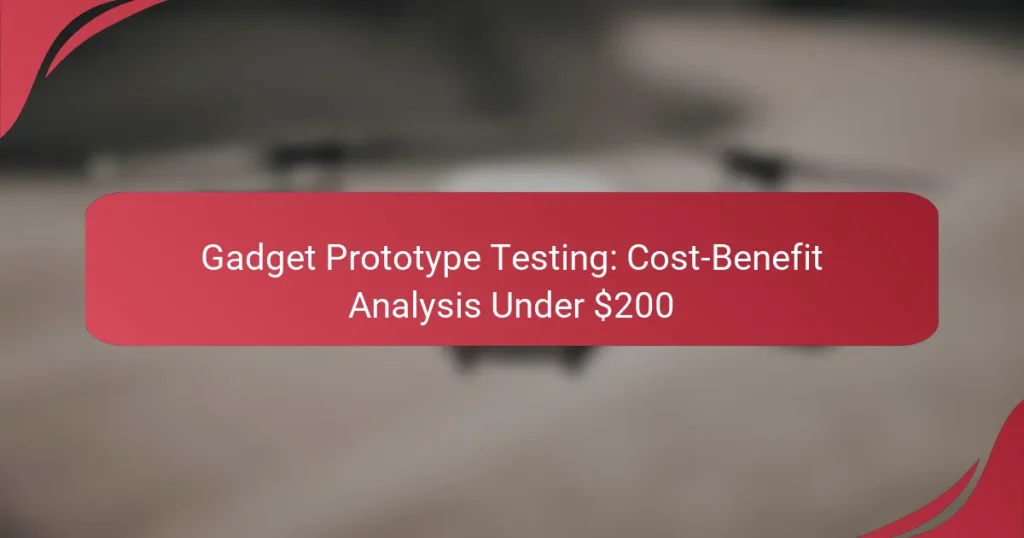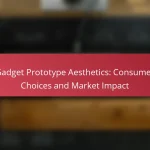Gadget prototype testing is essential for refining product designs and ensuring user satisfaction, all while staying within a budget of $200. By utilizing low-cost user testing, virtual prototyping tools, and DIY testing kits, you can gather valuable insights without overspending. Understanding the costs associated with materials and labor will help you effectively allocate your budget for a successful testing process.

What are the best methods for gadget prototype testing under $200?
The best methods for gadget prototype testing under $200 include low-cost user testing, virtual prototyping tools, and DIY testing kits. These approaches allow you to gather valuable feedback and insights without exceeding your budget.
Low-cost user testing
Low-cost user testing involves gathering feedback from real users to assess the functionality and usability of your gadget prototype. You can recruit participants through online platforms or local community groups, often offering incentives like gift cards or small cash payments to encourage participation.
To conduct effective user testing, prepare a set of tasks for users to complete with your prototype. Observe their interactions and gather qualitative feedback through interviews or surveys. Aim for a diverse group of testers to ensure a range of perspectives, ideally keeping costs under $100 for recruitment and materials.
Virtual prototyping tools
Virtual prototyping tools allow you to create and test digital models of your gadget without physical materials. Software like Sketch, Figma, or InVision can help you design interfaces and simulate user interactions at a fraction of the cost of traditional prototyping.
These tools often offer free or low-cost plans, making them accessible for startups and individual inventors. Use these platforms to iterate quickly based on user feedback, which can save time and resources in the long run. Consider investing around $50 to $100 for premium features or additional assets if necessary.
DIY testing kits
DIY testing kits enable you to build and test prototypes using readily available components. Kits can include basic electronics, sensors, and software to help you evaluate your gadget’s performance. Websites like Adafruit or SparkFun offer affordable components that can be assembled for under $200.
When using DIY kits, focus on key functionalities you want to test, such as durability or user interaction. Document your testing process and results to refine your prototype effectively. This hands-on approach not only saves money but also enhances your understanding of the design and engineering aspects of your gadget.

How much does gadget prototype testing cost?
The cost of gadget prototype testing typically ranges from $100 to $200, depending on various factors such as materials, labor, and software needs. Understanding these components can help you budget effectively for your testing process.
Average costs for materials
Material costs for gadget prototypes can vary widely based on the complexity and type of the gadget. Basic materials like plastics and metals may cost anywhere from $20 to $100, while specialized components could increase costs significantly.
When selecting materials, consider both durability and functionality. For instance, using cheaper materials might reduce initial costs but could lead to higher expenses later if the prototype fails during testing.
Labor costs for testing
Labor costs for testing can range from $30 to $100 per hour, depending on the expertise required. Hiring skilled technicians or engineers will generally be more expensive but can yield better results in terms of accuracy and reliability.
To manage labor costs, consider outsourcing to freelance professionals or using in-house resources if available. Ensure that the team has experience with the specific type of gadget being tested to avoid costly mistakes.
Software subscription fees
Software tools for prototype testing often come with subscription fees that can range from $10 to $50 per month. These tools may include simulation software, project management applications, or data analysis platforms.
Evaluate the software options carefully to ensure they meet your testing needs without exceeding your budget. Some platforms offer free trials, which can be beneficial for short-term projects or initial testing phases.

What are the benefits of testing prototypes?
Testing prototypes offers significant advantages, including the ability to refine product design, lower overall development costs, and increase user satisfaction. By identifying issues early, businesses can make informed decisions that enhance the final product.
Improved product design
Prototype testing allows designers to gather feedback on functionality and usability before full-scale production. This iterative process helps in identifying design flaws and user experience issues, leading to a more polished final product.
For example, a tech gadget prototype may reveal that certain buttons are difficult to reach or that the interface is not intuitive. Addressing these concerns early can result in a product that better meets user needs.
Reduced development costs
By identifying problems during the prototype phase, companies can avoid costly changes later in the development cycle. Fixing issues at the prototype stage is typically much cheaper than making adjustments after production has begun.
Consider a scenario where a gadget prototype reveals a need for a different material. Changing this at the prototype stage can save thousands of dollars compared to altering the design after mass production starts.
Enhanced user satisfaction
Testing prototypes directly involves potential users, which helps ensure that the final product aligns with their expectations and needs. This engagement fosters a sense of ownership and loyalty among users.
When users feel their feedback is valued, they are more likely to be satisfied with the final product. For instance, incorporating user suggestions on features can lead to a gadget that resonates better with its target audience, ultimately boosting sales and brand reputation.

What are the risks of not testing prototypes?
Not testing prototypes can lead to significant risks, including product failures, negative customer feedback, and increased return rates. These consequences can ultimately harm a brand’s reputation and financial performance.
Increased product failures
When prototypes are not tested, the likelihood of product failures rises sharply. Unidentified flaws can lead to malfunctions or subpar performance, which may result in costly recalls or repairs. Investing in prototype testing can help identify these issues early, saving time and resources in the long run.
For example, a tech gadget that fails to connect to Wi-Fi due to untested software can lead to a poor user experience. Testing prototypes allows developers to address such issues before the product reaches the market.
Negative customer feedback
Skipping prototype testing often results in negative customer feedback, which can severely damage a brand’s image. Customers expect products to work as advertised, and any discrepancies can lead to dissatisfaction and loss of trust. Gathering feedback during the prototype phase helps refine the product and align it with user expectations.
For instance, a home appliance that operates inefficiently due to design flaws may receive poor reviews, impacting future sales. Engaging customers in the testing process can provide valuable insights that enhance the final product.
Higher return rates
Not testing prototypes can lead to higher return rates, as customers may be dissatisfied with the product’s performance. When users encounter issues that could have been identified during testing, they are more likely to return the item, resulting in increased costs for the manufacturer. Understanding potential return triggers is essential for minimizing losses.
For example, a wearable fitness tracker that fails to accurately monitor heart rates may see a significant number of returns. Conducting thorough testing can help ensure that the product meets quality standards and reduces the likelihood of returns, ultimately benefiting the bottom line.

What criteria should be used for selecting testing methods?
Selecting testing methods for gadget prototypes involves evaluating factors like budget constraints, target audience feedback, and specific testing objectives. These criteria help ensure that the testing process is effective and aligns with the overall goals of the project.
Budget constraints
Budget constraints are a primary consideration when selecting testing methods. For projects with a budget under $200, it’s essential to prioritize cost-effective approaches, such as online surveys or in-person focus groups, which can provide valuable insights without significant expenses.
Consider allocating funds strategically across different testing methods. For example, you might spend a portion on materials for prototype testing and another on participant incentives. Keeping track of expenses will help you stay within budget while maximizing the quality of feedback.
Target audience feedback
Gathering feedback from your target audience is crucial for refining your gadget prototype. Identify who your end-users are and tailor your testing methods to engage them effectively. This could involve direct interviews, usability tests, or online feedback forms.
Utilize platforms that allow you to reach your audience efficiently. For instance, social media or community forums can be excellent venues for collecting opinions and suggestions, often at little to no cost. Ensure that the feedback process is straightforward to encourage participation.
Testing objectives
Clearly defined testing objectives guide the selection of appropriate methods. Determine what you want to learn from the testing process, whether it’s usability, functionality, or market interest. This clarity will help you choose the right tools and approaches.
For example, if your objective is to assess usability, consider conducting hands-on sessions where users interact with the prototype while you observe. If gauging market interest is the goal, surveys or pre-launch campaigns can be effective. Align your methods with these objectives to ensure meaningful results.

How can I maximize the effectiveness of my prototype testing?
To maximize the effectiveness of your prototype testing, focus on clear objectives and gather actionable feedback. Establish a structured approach that allows for quick iterations and adjustments based on user input.
Iterative testing approach
An iterative testing approach involves repeatedly refining your prototype based on user feedback. This method allows you to identify issues early and make necessary adjustments, ultimately leading to a more effective final product.
Start with a basic version of your prototype and conduct tests with a small group of users. Gather their insights, implement changes, and then retest. This cycle can be repeated several times, often resulting in significant improvements with each iteration.
Consider allocating a budget of around $200 for materials and user incentives. This can cover basic supplies and small rewards for participants, ensuring you gather valuable feedback without overspending.


